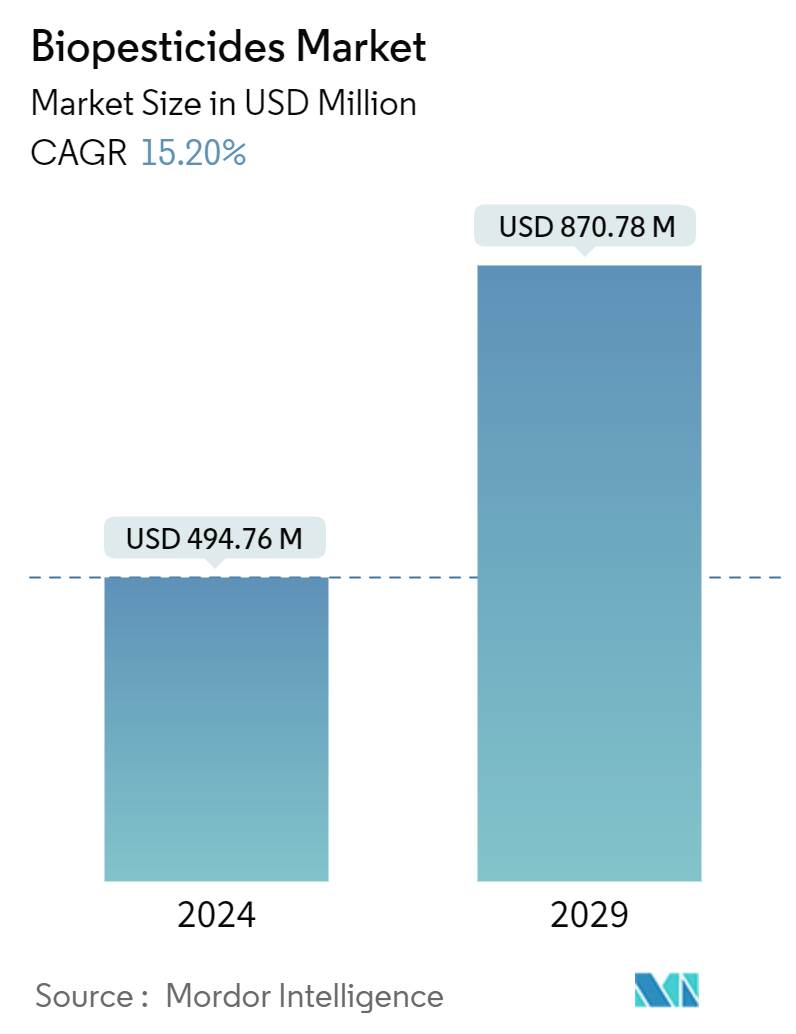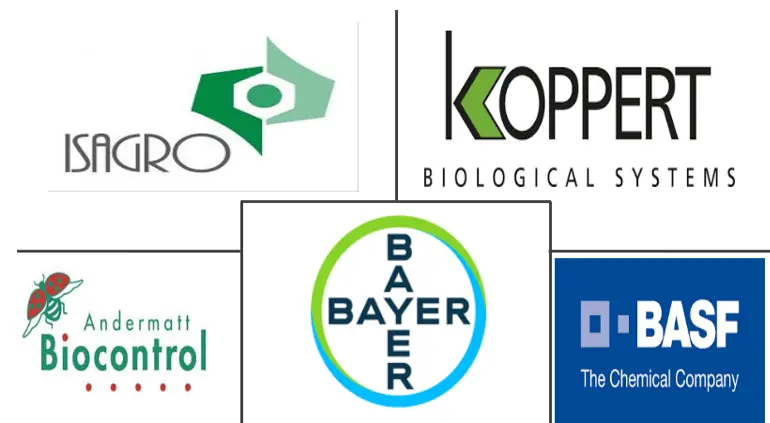Market Size of Spain Biopesticides Industry

| Study Period | 2019 - 2029 |
| Base Year For Estimation | 2023 |
| Market Size (2024) | USD 494.76 Million |
| Market Size (2029) | USD 870.78 Million |
| CAGR (2024 - 2029) | 15.20 % |
| Market Concentration | Low |
Major Players
*Disclaimer: Major Players sorted in no particular order |
Need a report that reflects how COVID-19 has impacted this market and its growth?
Spanish Biopesticide Market Analysis
The Biopesticides Market size is estimated at USD 494.76 million in 2024, and is expected to reach USD 870.78 million by 2029, growing at a CAGR of 15.20% during the forecast period (2024-2029).
The biopesticides market is gaining recognition as a cornerstone of sustainable agriculture, providing a natural alternative to conventional chemical pesticides. The global surge in demand for biopesticides is driven by growing concerns over environmental impact and human health. Derived from natural materials such as plants, bacteria, and minerals, these biological products are essential for controlling pests with minimal impact on non-target species, including humans, animals, and beneficial insects. The adoption of biopesticides aligns with the global movement towards organic farming and integrated pest management (IPM) practices, both crucial for maintaining soil health and biodiversity.
Industry Trends and Innovations
- Growth in Sustainable Agriculture: The biopesticides industry is experiencing significant advancements in research and development, fueled by the demand for sustainable pest control solutions. Technological innovations are playing a crucial role in enhancing the efficacy and adoption of biopesticides. The increasing awareness of the benefits of biological pest management over synthetic chemicals is further boosting the biopesticides market size. Additionally, stringent regulatory frameworks imposed by governments worldwide are encouraging the use of biopesticides, helping reduce the ecological footprint of agriculture.
- Segmentation by Product Type: The biopesticides market is segmented by product types, including bioherbicides, bioinsecticides, and biofungicides. Each segment plays a vital role in different agricultural applications, both in crop-based and non-crop-based settings. The rising demand for organic products is propelling the use of biopesticides in crop protection, particularly in fruits, vegetables, and cereals. Moreover, non-crop-based applications, such as public health and turf management, are also contributing to the expanding market value of biopesticides.
- Competitive Landscape: The biopesticides market is characterized by the presence of both multinational corporations and regional players. Leading companies like Bayer Crop Science, BASF, and Valent Biosciences are driving the market through substantial investments in research and development and strategic collaborations. These market leaders are continuously innovating to enhance product efficacy and expand their product portfolios to meet the diverse needs of the agricultural sector. The entry of smaller companies and startups offering niche products is intensifying competition, targeting specific pests or crops.
Strategic Adoption in the Biopesticides Industry
- Organic Farming Practices: The increasing demand for organic biopesticides is a key factor in the biopesticides market growth. Organic farming practices emphasize the use of natural inputs, making biopesticides an essential component of sustainable agriculture. This trend is supported by growing consumer awareness and preference for organic products, positively influencing the biopesticides market forecast. Regulatory bodies across various regions are also promoting biopesticides as part of integrated pest management strategies, further accelerating market growth.
- Technological Innovations: Advancements in microbial and botanical biopesticides are shaping the biopesticides industry outlook. Companies are investing in research to develop more effective and targeted biopesticide formulations, improving their ability to control pests without harming beneficial organisms. These innovations address the limitations of traditional pesticides, such as pest resistance and environmental degradation, making biopesticides a viable and sustainable alternative in modern agriculture.
Challenges in Market Expansion
- Regulatory and Compliance Issues: The regulatory landscape for biopesticides varies significantly across regions, presenting challenges for market players. Compliance with stringent regulations and obtaining approvals for new products can be time-consuming and costly, affecting the pace of market expansion. However, these regulations are crucial in ensuring that biopesticides are safe and effective, ultimately benefiting the industry's long-term growth. Companies need to navigate these complexities carefully to maintain their market share and capitalize on emerging opportunities.
- Competition from Synthetic Pesticides: Despite the numerous advantages of biopesticides, competition from synthetic pesticides remains a significant restraint. Synthetic chemicals often offer quicker results and are sometimes perceived as more reliable, particularly in large-scale farming operations. Educating farmers and stakeholders about the long-term benefits and sustainability of biopesticides is essential to overcome this barrier and enhance the adoption rate of biological pest management solutions.
Spanish Biopesticide Industry Segmentation
According to EPA, 'Biopesticides are certain types of pesticides, derived from such natural materials as animals, plants, bacteria, and certain minerals.' The present study takes into consideration both microbial and organic pesticides. The market is broadly segmented into bioinsecticide, bioherbicide, biofungicide, and others. The market is segmented by product type into bio-herbicides, bio-insecticides, bio-fungicides and others. By application the market is segmented into crop based and non crop based. The market sizing has been done in value terms in USD for all the abovementioned segments.
| Product Type | |
| BioHerbicides | |
| BioInsecticides | |
| BioFungicides | |
| Others |
| Application | |
| Crop based | |
| Non Crop based |
Spain Biopesticides Market Size Summary
The Spain biopesticide market is experiencing growth driven by increasing concerns over human, animal, and environmental health, which are prompting a shift away from chemical pesticides. The market benefits from an easy registration process and lower research and development costs, although challenges such as higher product costs and shorter shelf life compared to chemical alternatives persist. The rise in organic farming, fueled by consumer demand for organic food and the high cost of chemical pesticides, is a significant factor propelling the market forward. Government initiatives and regulatory support have further encouraged the adoption of biopesticides, making Spain a leading market in this sector due to its substantial organic farming practices.
The demand for organic products is on the rise, supported by higher incomes and improved farming practices that enhance organic yields. Both private and public sectors are investing in research on microbial and plant extracts with biocidal properties, which is expected to drive market expansion. The biopesticide market is characterized by strategic activities such as new product launches, partnerships, and acquisitions by key players like Valent Biosciences Corporation, Koppert BV, LLC, Bayer Cropscience AG, and Syngenta. The market remains highly fragmented, with these companies competing not only through innovation but also by pursuing strategic moves to capture larger market shares.
Spain Biopesticides Market Size - Table of Contents
-
1. MARKET DYNAMICS
-
1.1 Market Overview
-
1.2 Market Drivers
-
1.2.1 Rise of Sustainable Agriculture
-
1.2.2 Favorable Government Initiatives Toward Organic Farming
-
-
1.3 Market Restraints
-
1.3.1 Regulatory and Compliance Issues
-
1.3.2 Competition from Synthetic Pesticides
-
-
1.4 Porters Five Force Analysis
-
1.4.1 Threat of New Entrants
-
1.4.2 Bargaining Power of Buyers/Consumers
-
1.4.3 Bargaining Power of Suppliers
-
1.4.4 Threat of Substitute Products
-
1.4.5 Intensity of Competitive Rivalry
-
-
-
2. MARKET SEGMENTATION
-
2.1 Product Type
-
2.1.1 BioHerbicides
-
2.1.2 BioInsecticides
-
2.1.3 BioFungicides
-
2.1.4 Others
-
-
2.2 Application
-
2.2.1 Crop based
-
2.2.2 Non Crop based
-
-
Spain Biopesticides Market Size FAQs
How big is the Spain Biopesticides Market?
The Spain Biopesticides Market size is expected to reach USD 494.76 million in 2024 and grow at a CAGR of 15.20% to reach USD 870.78 million by 2029.
What is the current Spain Biopesticides Market size?
In 2024, the Spain Biopesticides Market size is expected to reach USD 494.76 million.

